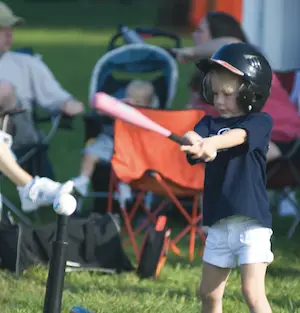Central to the T-ball experience are chants. those rhythmic and catchy phrases that inspire fun.
In this article we explore examples and the way chants can be used in t-ball. Whether you’re a coach, parent, or player, this article will give you all you need for t-ball chants.

Table of Contents
T-Ball Chants
- Chant: “Swing, Batter, Swing!”
- Lyrics: “Swing, batter, swing, we want a hit, to bring our runner in!”
- Meaning: This chant is a classic encouragement for the batter to hit the ball and score a run.
- When to Use: Use this chant when your team is batting, particularly when there’s a player on base ready to run home.
- Chant: “Go, Go, Go!”
- Lyrics: “Go, go, go, run fast to the base, don’t be slow!”
- Meaning: This chant motivates players to run quickly between bases.
- When to Use: Chant this when a player on your team hits the ball and is running to a base.
- Chant: “Defense, Hold Strong”
- Lyrics: “Defense, hold strong, catch that ball, can’t go wrong!”
- Meaning: This chant is used to encourage the defensive side of the team to stay alert and make good plays.
- When to Use: Use this when your team is in the field, especially when the opposing team is batting.
- Chant: “We Believe”
- Lyrics: “We believe, we believe, we can win, just you see!”
- Meaning: This chant is about team spirit and the belief in the team’s ability to win.
- When to Use: This is a great chant for any time during the game to boost morale, especially if the team is behind.
- Chant: “One, Two, Three”
- Lyrics: “One, two, three, hit that ball, just watch me!”
- Meaning: It’s a chant to boost the batter’s confidence.
- When to Use: Use this chant when a player from your team is up to bat.
- Chant: “Catch That Ball”
- Lyrics: “Catch that ball, catch that ball, jump high, don’t let it fall!”
- Meaning: This chant encourages players in the field to stay focused and catch any balls that come their way.
- When to Use: Chant this when the opposing team is batting and a ball is hit into the field.
- Chant: “Run, Run, Run!”
- Lyrics: “Run, run, run, as fast as you can, make it to the base, that’s the plan!”
- Meaning: This chant is all about speed and making it safely to the next base.
- When to Use: Use this when a player on your team is running from one base to another.
- Chant: “Let’s Get a Hit”
- Lyrics: “Let’s get a hit, a nice big hit, swing that bat, this is it!”
- Meaning: This chant is an encouragement for the batter to make a good hit.
- When to Use: This is ideal when your team is batting, to encourage the batter.
- Chant: “Outfielders, Ready”
- Lyrics: “Outfielders, ready, in your stance, catch that ball, don’t miss your chance!”
- Meaning: It focuses on the outfielders, encouraging them to be prepared and alert.
- When to Use: Chant this when your team is fielding, particularly focusing on outfield players.
- Chant: “We’re a Team”
- Lyrics: “We’re a team, we’re a crew, together strong, through and through!”
- Meaning: This chant emphasizes teamwork and unity.
- When to Use: This is a great general chant for team spirit, suitable for any time during the game.
- Chant: “Big Hit, Big Cheer”
- Lyrics: “Big hit, big cheer, knock that ball out of here!”
- Meaning: This chant is a rallying cry for a big hit, encouraging the batter to aim for a powerful hit.
- When to Use: Use this chant when your team’s batter is up, especially in a crucial hitting moment.
- Chant: “Hustle and Run”
- Lyrics: “Hustle and run, don’t stop, keep going, having fun!”
- Meaning: This chant motivates players to keep moving quickly and enjoy the game.
- When to Use: Chant this when players are running the bases or moving quickly in the field.
- Chant: “Strike Them Out”
- Lyrics: “Strike them out, strike them out, make them miss, without a doubt!”
- Meaning: This chant is for encouraging the pitcher or the fielding team to get a strikeout.
- When to Use: Use it when your team is in the field, and the pitcher is trying to get a batter out.
- Chant: “Bases Loaded”
- Lyrics: “Bases loaded, full of speed, bring them home, that’s what we need!”
- Meaning: This chant is about capitalizing on a bases-loaded situation to score runs.
- When to Use: Chant this when your team has bases loaded and you’re looking to score.
- Chant: “Fielders Be Ready”
- Lyrics: “Fielders be ready, get set to play, catch that ball, show them our way!”
- Meaning: It emphasizes alertness and skill for the fielding team.
- When to Use: Use this when your team is in the field, ready to defend against the hitters.
- Chant: “Slide Into Base”
- Lyrics: “Slide into base, with all your might, safe and sound, you’ve got it right!”
- Meaning: This chant is about the excitement and technique of sliding into a base safely.
- When to Use: Chant this when a player is about to slide into a base.
- Chant: “Cheer Them On”
- Lyrics: “Cheer them on, loud and clear, show our team we’re always here!”
- Meaning: This chant is about showing unwavering support for the team.
- When to Use: This is a great general chant for boosting team morale, suitable at any point in the game.
- Chant: “Quick and Agile”
- Lyrics: “Quick and agile, fast and strong, that’s our team, all game long!”
- Meaning: It emphasizes the agility and strength of the team.
- When to Use: Use this to motivate the team, particularly when they’re fielding.
- Chant: “Let’s Steal a Base”
- Lyrics: “Let’s steal a base, sneaky and fast, make that move, sure to last!”
- Meaning: This chant is about the excitement and strategy of successfully stealing a base.
- When to Use: Chant this when a player on your team is in a good position to steal a base.
- Chant: “Together We Stand”
- Lyrics: “Together we stand, together we play, team strong, all the way!”
- Meaning: It’s about unity and collective strength of the team.
- When to Use: Use this chant to foster team spirit, particularly in team huddles or at the start or end of a game.
- “We Are the Team to Beat”
- Lyrics: “We are the team to beat, can’t be beat, won’t be beat!”
- Meaning: This chant is all about confidence and team pride. It sends a strong message of unity and determination.
- When to Use: Ideal for the start of the game or when the team needs a morale boost.
- “Awesome at Bat”
- Lyrics: “Awesome at bat, swinging with might, watch that ball take flight!”
- Meaning: Focused on encouraging the batter, this chant boosts confidence and aims to excite the team about the potential of a great hit.
- When to Use: Perfect for when a team member is up to bat, ready to hit.
- “Glove on the Ball”
- Lyrics: “Glove on the ball, quick on your feet, fielding so neat!”
- Meaning: This chant emphasizes skill in fielding, encouraging players to be alert and ready to make a play.
- When to Use: Use when the team is fielding, particularly during tense moments when focus is crucial.
- “Runners on the Move”
- Lyrics: “Runners on the move, swift and fast, heading home at last!”
- Meaning: It’s about the thrill and strategy of base running, encouraging speed and determination.
- When to Use: Great for when players are running the bases, especially heading towards home plate.
- “Strike Out Strong”
- Lyrics: “Strike out strong, pitch with might, send those batters out of sight!”
- Meaning: Aimed at the pitcher, this chant encourages strength and precision in pitching to get the opposing batters out.
- When to Use: Best used when your team is pitching, particularly in high-pressure situations.
- “Catch and Throw”
- Lyrics: “Catch and throw, fast and sharp, keeping the game on par!”
- Meaning: This chant focuses on the essential skills of catching and throwing accurately in the field.
- When to Use: Useful during practice sessions or games to remind players of the fundamentals.
- “Cheering Loud and Proud”
- Lyrics: “Cheering loud and proud, for our team, we stand out in the crowd!”
- Meaning: This is about the role of the supporters, emphasizing the importance of cheering and creating a lively atmosphere.
- When to Use: Perfect for supporters and players on the bench to keep the energy high throughout the game.
- “Hit, Run, Score”
- Lyrics: “Hit, run, score, that’s our game, every inning, just the same!”
- Meaning: This chant encompasses the basic elements of the game – hitting, running, and scoring – in a simple, rhythmic way.
- When to Use: This is a versatile chant, good for any part of the game.
- “Defense! Defense!”
- Lyrics: “Defense! Defense! Strong and tight, keep the win in sight!”
- Meaning: A staple in many team sports, this chant is all about rallying the team to hold a strong defensive line.
- When to Use: When the team is fielding, especially during crucial defensive plays.
- “One Team, One Dream”
- Lyrics: “One team, one dream, together we’re supreme!”
- Meaning: This chant encapsulates the unity and shared goals of the team, emphasizing teamwork and collective effort.
- When to Use: Great for team huddles and to remind players of their shared objectives and teamwork.
Creating Effective T-Ball Chants
Crafting chants that resonate with young T-ball players requires a blend of creativity, simplicity, and an understanding of what excites and motivates children. Here are some key considerations and tips for creating effective T-ball chants:
- Keep It Simple and Memorable
- The best chants are those that are easy to remember and repeat. Use simple, rhythmic words that young players can easily recall and say. Short phrases and repetitive structures work best.
- Incorporate Rhyme and Rhythm
- Chants with a good rhyme and rhythm are more engaging and fun to recite. They can also help players keep time and maintain energy during the game.
- Focus on Positive Messages
- The content of the chants should be positive and encouraging. They should foster a spirit of teamwork, sportsmanship, and fair play. Avoid anything that could be construed as negative or taunting.
- Make Them Inclusive
- Ensure that the chants are inclusive and appropriate for all players. They should celebrate the team as a whole and not single out individuals, unless in a positive and supportive manner.
- Reflect Team Identity
- Personalize chants to reflect your team’s identity, mascot, colors, or motto. This not only makes them unique to your team but also helps in building a sense of unity and pride among the players.
- Encourage Creativity
- Involve the team in creating their own chants. This not only fosters team bonding but also ensures that the chants resonate more with the players. They’ll be more likely to remember and enjoy chants that they had a hand in creating.
- Teach Through Chants
- Chants can be a fun way to teach the basics of the game. Incorporating terms and strategies of T-ball into the chants can help reinforce learning in an enjoyable way.
- Consider the Occasion
- Create different chants for various situations in the game – for batting, fielding, cheering from the sidelines, etc. This adds variety and keeps the chants specific and relevant.
- Practice Makes Perfect
- Regularly practice the chants during team practices. This helps the players get comfortable with them and builds confidence in using them during games.
- Keep Updating Your Chants
- Don’t be afraid to evolve your chants as the season progresses. New experiences, games, and team dynamics can all be reasons to introduce new chants or modify existing ones.
By following these tips, coaches, parents, and team leaders can create effective and enjoyable chants that elevate the T-ball experience. These chants become more than just words; they are a vehicle for expressing team spirit, unity, and joy in the game.
Parental Involvement in T-Ball Chants
The role of parents in T-ball extends beyond mere spectating; their involvement can significantly enhance the experience for young players. Here’s a deeper look into how parents can contribute positively to the aspect of T-ball chants:
- Encouraging Participation
- Parents can encourage their children to participate in team chants. This can be done through practicing chants at home or showing enthusiasm for the chants during games. Such encouragement boosts the child’s confidence and willingness to engage.
- Creating a Supportive Environment
- By joining in or applauding the chants, parents help create a supportive and exciting game environment. This collective enthusiasm from the sidelines can be infectious and uplifting for the players.
- Teaching Sportsmanship
- Parents have a key role in modeling and teaching sportsmanship. This includes showing respect for all chants, whether from their child’s team or the opposing team, and discouraging any negative responses to the performance of any player or team.
- Helping with Chant Creation
- Parents can be involved in helping their children or the team come up with new chants. This can be a fun activity that also strengthens the bond between parent and child, and between the parents and the team.
- Promoting Inclusivity
- Ensuring that chants are inclusive and respectful is crucial. Parents can help monitor the language and content of chants to ensure they are appropriate for all players and families.
- Building Community
- Chants can be a way to build a sense of community among parents and families. Parents can coordinate to create a unified cheering section, bringing together banners, coordinated cheers, and a shared enthusiasm that fosters a sense of community.
- Feedback and Suggestions
- Parents can provide valuable feedback and suggestions on chants. Their perspective can help refine the chants to make them more enjoyable and effective.
- Respecting Coach’s Guidance
- It’s important for parents to respect the coach’s guidance regarding chants. This includes following the coach’s instructions on when and how to use chants, to ensure they align with the team’s strategy and game dynamics.
- Learning the Game
- Understanding the basics of T-ball can help parents engage more effectively with the chants. Knowing when certain chants are appropriate and how they relate to the game can enhance their participation.
- Encouraging Respect for Officials
- Parents should use chants as an opportunity to teach children respect for game officials and the decisions they make. This helps in nurturing a respectful attitude towards authority figures in the sport.
Challenges in Implementing Chants
Implementing chants in T-ball, while beneficial, can come with its own set of challenges. Understanding and addressing these challenges can help ensure that chants positively contribute to the game experience for young players.
- Overcoming Shyness and Reluctance
- Many young players may feel shy or reluctant to chant loudly in a group setting. Coaches and parents can help by creating a welcoming and non-judgmental environment where every child feels comfortable participating at their own pace.
- Ensuring Uniform Participation
- It can be challenging to get all team members to participate equally in chants. Encouraging teamwork and explaining the importance of everyone’s participation can help. Recognizing and appreciating the efforts of all players, not just the loudest or most enthusiastic, is also crucial.
- Balancing Focus and Fun
- While chants are meant to be fun, they can sometimes distract players from the game itself. Coaches need to find the right balance, ensuring that chants enhance the game experience without detracting from players’ focus on the game.
- Age-Appropriate Language and Themes
- Ensuring that the content of the chants is age-appropriate and easy to understand for young players is essential. This might require tailoring traditional chants or creating entirely new ones that resonate with the younger age group.
- Handling Competitive Spirits
- Chants can sometimes fuel overly competitive spirits, especially in games against rival teams. It’s important to steer the energy of chants towards positive and sportsmanlike behavior, emphasizing respect for all players and teams.
- Cultural Sensitivity
- In today’s diverse communities, it’s crucial to ensure that chants are culturally sensitive and do not inadvertently offend or exclude any group. This includes being mindful of language, references, and themes used in chants.
- Dealing with Noise Levels
- At times, chants can get excessively loud, which might be overwhelming for some children or even cause disruptions. Setting clear guidelines on volume and duration can help manage noise levels.
- Integrating New Members
- Teams often have new members joining, who might not be familiar with existing chants. Ensuring that these players are quickly brought up to speed and feel included in the team’s traditions is important.
- Avoiding Monotony
- Repeating the same chants can become monotonous. Continually refreshing the repertoire of chants and encouraging creativity can keep the excitement alive.
- Adapting to Virtual or Distanced Settings
- In situations where teams might not be able to gather closely, such as during virtual meetings or in socially-distanced practices, finding ways to effectively incorporate chants can be a challenge. Using technology or modifying chants to suit these settings can be helpful.
FAQ
Why are chants used in T-ball?
Chants in T-ball are used to build team spirit, engage young players, and create an enjoyable atmosphere during the game. They help in developing rhythm, coordination, and a sense of unity among the players.
Can anyone participate in T-ball chants?
Yes, everyone, including players, coaches, and parents, can participate in T-ball chants. In fact, parental involvement is encouraged to create a supportive environment for the children.
See Related Posts

Gregorian Christmas Chants

Love Spell Chants

Best Softball Chants for U12

AKA Sorority Chants

Argentina Football Chants

Short Chants and Cheers

Alabama Football Chants

Everything to Know About African Chants

